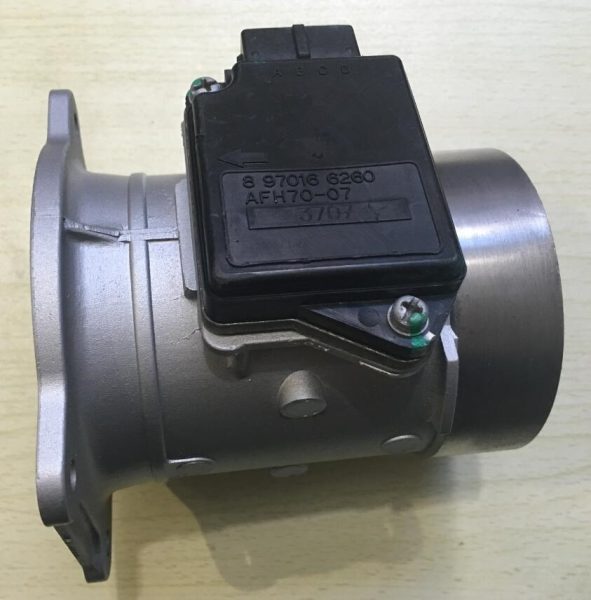
The device and principle of operation of the DMRV
Content
To ensure an optimal fuel combustion process and compliance with the specified environmental standards, it is necessary to determine as accurately as possible the mass flow of air supplied to the engine cylinders, depending on its operating modes. This process can be controlled by a whole set of sensors: an air pressure sensor, a temperature sensor, but the most popular of them is a mass air flow sensor (MAF), which is sometimes also called a flow meter. Mass air flow sensor records the amount (mass) of air coming from the atmosphere into the engine intake manifold and transmits this data to the electronic control unit for subsequent calculation of the fuel supply.
Types and features of flow meters
Explanation of the abbreviation DMRV - mass air flow sensor. The device is used in cars with gasoline and diesel engines. It is located in the intake system between the air filter and the throttle valve and connects to the engine ECU. In the absence or malfunction of the flow meter, the calculation of the amount of incoming air is carried out according to the position of the throttle valve. This does not give an accurate measurement, and in difficult operating conditions, fuel consumption increases, since mass air flow is a key parameter for calculating the amount of fuel injected.
The principle of operation of the mass air flow sensor is based on measuring the temperature of the air flow, and therefore this type of flow meter is called hot-wire anemometer. Two main types of mass air flow sensors are structurally distinguished:
- filament (wire);
- film;
- volumetric type with a butterfly valve (at the moment it is practically not used).
Design and principle of operation of the wire gauge
Nitievoy DMRV has the following device:
- the body;
- measuring tube;
- sensitive element - platinum wire;
- thermistor;
- voltage transformer.
The platinum filament and thermistor are both a resistive bridge. In the absence of air flow, the platinum filament is constantly heated to a predetermined temperature by passing an electric current through it. When the throttle valve opens and air begins to flow, the sensing element is cooled, which reduces its resistance. This causes the “heating” current to increase to balance the bridge.
The converter transforms the current changes in current into an output voltage, which is transmitted to the engine ECU. The latter, based on the existing non-linear relationship, calculates the amount of fuel supplied to the combustion chambers.
This design has one significant drawback - over time, malfunctions occur. The sensing element wears out and its accuracy drops. They can also get dirty, but to solve this problem, the wire mass air flow sensors installed in modern cars have a self-cleaning mode. It involves short-term heating of the wire to 1000 ° C with the engine off, which leads to the burning of accumulated contaminants.
Scheme and features of the film DFID
The principle of operation of the film sensor is in many ways similar to the filament sensor. However, there are several differences in this design. Instead of a platinum wire, a silicon crystal is installed as the main sensitive element. The latter has platinum sputtering, consisting of several thinnest layers (films). Each of the layers is a separate resistor:
- heating;
- thermistors (there are two of them);
- air temperature sensor.
The sputtered crystal is placed in a housing that is connected to the air supply channel. It has a special design that allows you to measure the temperature of not only the incoming, but also the reflected flow. Since air is sucked in by vacuum, the flow rate is very high, which prevents dirt from accumulating on the sensing element.
Just like in a filament sensor, the sensing element heats up to a predetermined temperature. When air passes through the thermistors, a temperature difference arises, on the basis of which the mass of the flow coming from the atmosphere is calculated. In such designs, the signal to the engine ECU can be supplied both in an analog format (output voltage), and in a more modern and convenient digital format.
Consequences and signs of malfunction of the mass air flow sensor
As with any type of engine sensor, faults in the mass air flow sensor mean incorrect calculations of the engine ECU and, as a result, incorrect operation of the injection system. This can cause excessive fuel consumption or, conversely, insufficient supply, which reduces engine power.
The most striking symptoms of a sensor malfunction:
- Appearance of the “Check Engine” signal on the dashboard of the car.
- Significant increase in fuel consumption during normal operation.
- Reducing the intensity of engine acceleration.
- Difficulties with starting the engine and the occurrence of spontaneous stops in its operation (the engine stalls).
- Operation only at one specific speed level (low or high).
If you find signs of a problem with the MAF sensor, try disabling it. An increase in engine power will be a confirmation of a DMRV breakdown. In this case, it will need to be rinsed or replaced. In this case, it is necessary to select the sensor recommended by the car manufacturer (that is, the original one).

